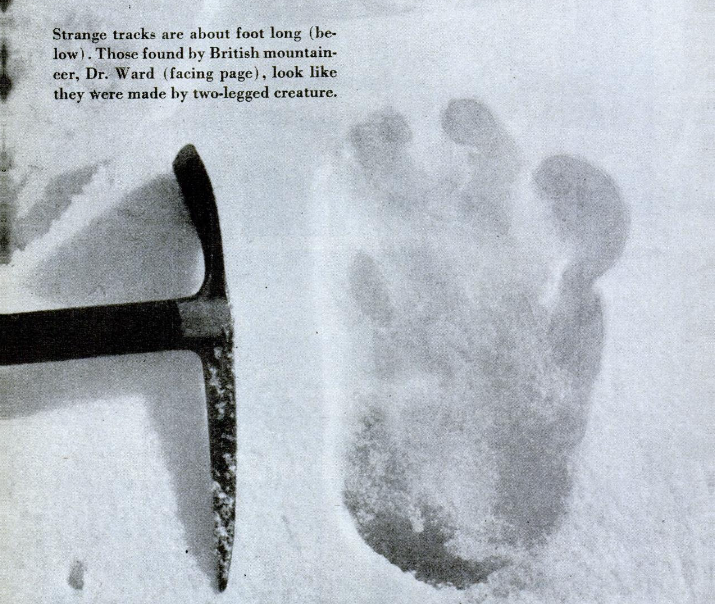In real life, or at least real-life folklore, the Yeti is an ape-like creature that the Sherpa people of the Himalayas have historically believed to be a mystical being.
The notion of Yeti-as-cryptozoological phenomenon arose in the 19th century, and it really gained steam in 1951, when the mountaineering explorer Eric Shipton, while trekking along the Menlung Glacier near the Tibet-Nepal border, took a famous photograph of a large footprint next to a pickaxe.

In August, National Geographic interviewed Daniel Taylor, author of "Yeti: The Ecology of a Mystery." Taylor called the photo "the Rosetta Stone in Yeti lore" ...
What was captivating about the prints was that they’re really sharp. The snow was hard so the photo looks like a sort of plaster of Paris cast. The second feature was that the prints looked like a human footprint, but with a thumb. So, you get this primate-like feeling but hominoid at the same time. Its enormous size — 13 inches — also suggests a magnificent hominoid, a King Kong type of image! And the media grabbed it.
Further Yeti-questing expeditions followed, including one by Edmund Hillary.
There have been many sightings over the years and even a few instances of people collecting biological samples like skin, hair, bones and teeth. These can be found in private collections or even in places like the Messner Mountain Museum in the Italian Alps.
Enter Science
All this has made for a great story, which is now a little less so. According to a recently released DNA study, it looks like at least nine of these samples have been identified as coming from known animals. Eight of them match one or the other of the two types of bears found in the area -- the Himalayan brown bear and the Tibetan brown bear. A tooth that was examined actually came from a dog.
There are probably other samples that can be tested, but for now, there is no genetic evidence that the creature known as the Yeti is real.
In order to do this analysis, these researchers needed to get good DNA from Himalayan black and brown bears. They got samples from a zoo in Pakistan as well as from the wild. There was already good data available for the Tibetan brown bear.
The researchers focused on a small bit of mitochondrial DNA, which was easily obtainable from the fur samples the investigators had. mtDNA was also used because most of the museum samples were beat up, requiring lots of copies in each sample's cells to increase the chances of finding usable DNA. mtDNA contains hundreds or even thousands of copies per cell instead of the usual two.
Due to better technology, the scientists were also able to look at the entire sequence of mtDNA. That was not possible in earlier studies, and it allowed them to more precisely assign the samples to specific animals.
In the process, the researchers learned a bit about the evolutionary history of the Himalayan brown bear. They found that this type of bear originally split from other brown bears 650,000 years ago, the result of massive glaciers that are thought to have arrived, possibly isolating the Himalayan bears' ancestors from the original group. Left alone, they evolved into a new subspecies.
Now that scientists have worked out the conditions for extracting and sequencing mtDNA, this method can be applied to other museum specimens. It might even be used to confirm earlier work that showed Sasquatch samples most likely came from a horse, bear or wide variety of other common hairy beasts.
Yes, sometimes, science can be a real party pooper.
